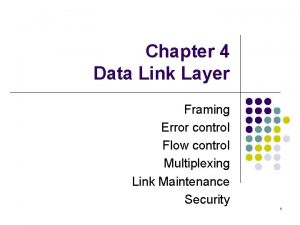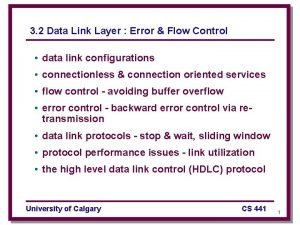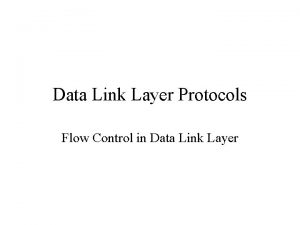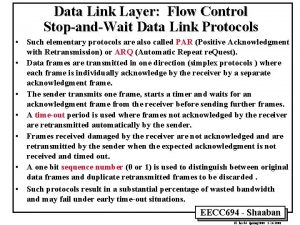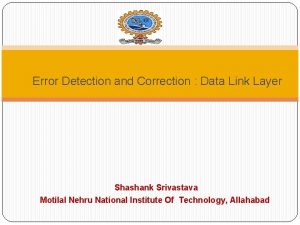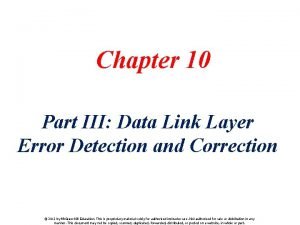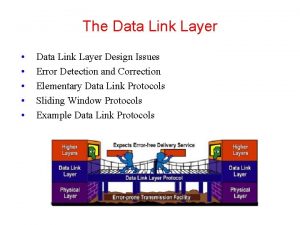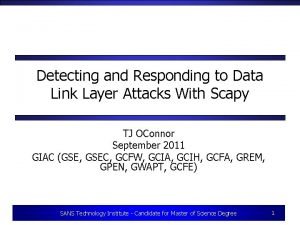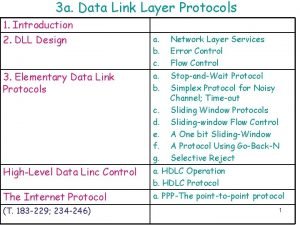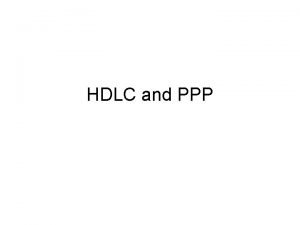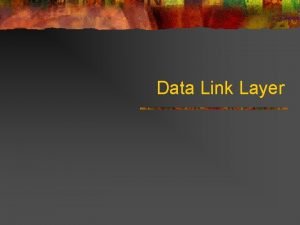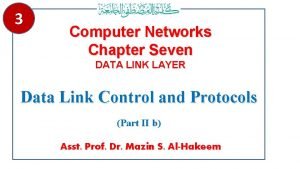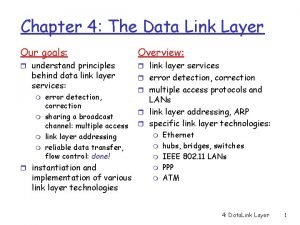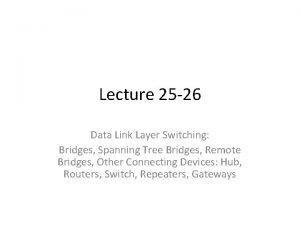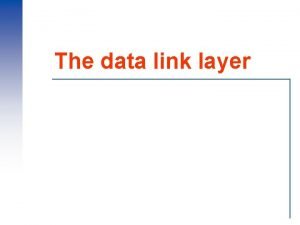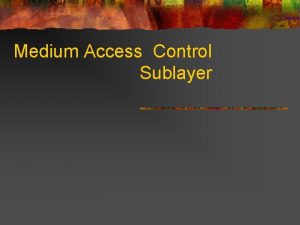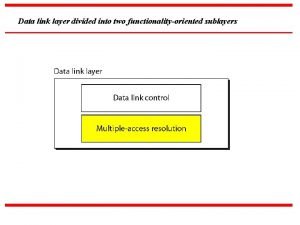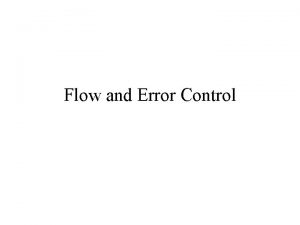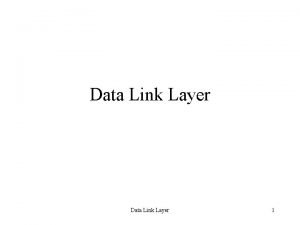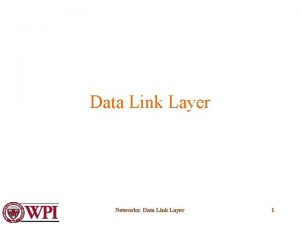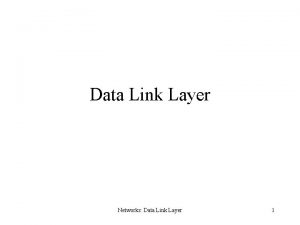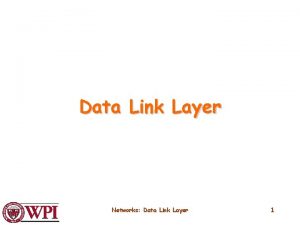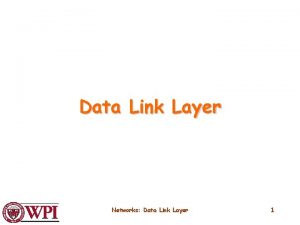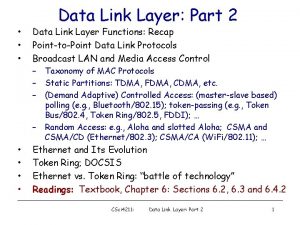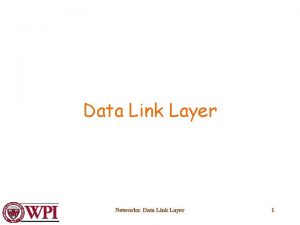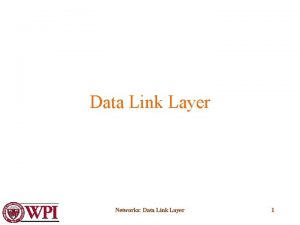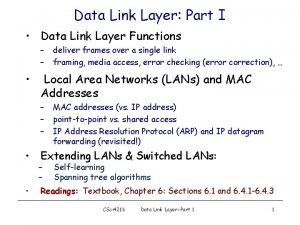3 2 Data Link Layer Error Flow Control
































- Slides: 32

3. 2 Data Link Layer : Error & Flow Control • data link configurations • connectionless & connection oriented services • flow control - avoiding buffer overflow • error control - backward error control via retransmission • data link protocols - stop & wait, sliding window • protocol performance issues - link utilization • the high level data link control (HDLC) protocol University of Calgary CS 441 1

Line Configurations • Topology point to point multipoint . . . • Duplicity simplex half duplex full duplex University of Calgary CS 441 2

Point to Point - example • Establishment - ENQ (enquiry), ACK, NAC, ERP (error procedure) • Data Transfer • Termination - EOT ENQ A ACK B frame ACK University of Calgary CS 441 3

Multipoint Links - Primary & Secondary Nodes • Polling + P : POLL - X (note: need address) + X : NAK or X : frame to P + P : ACK • Select + P : SEL - X + X : ACK + P : frame to X + X : ACK University of Calgary CS 441 4

Flow Control - Stop & Wait • Receiver (B) needs one buffer + A sends Frame to B + B sends ACK to A + A sends Frame to B +. . . • Assumes no errors, in frames or ACKs • Small frames, or blocks, are: + fairer, fewer re-xmit, smaller buffers required University of Calgary CS 441 5

Performance - Link Utilization = U • TF = total time to send frame • = one way propagation delay • TF = Tf +2 +Tack ~= Tf +2 • U ~= n Tf / (2 n +n. Tf) => U = 1/ (1+2 a) + where a = / Tf Tf A University of Calgary B CS 441 6

Definition of Parameter “a” • a = propagation time / transmission time • d = distance • V = velocity of light = 2 or 3 * 8 meters/sec • R = data rate in bits/sec • L = length of frame in bits a = / Tf a = (d/ V)/ (L/ R) a = Rd/ VL University of Calgary CS 441 7

Impact of a on Utilization a = / Tf < 1 Tf A B Tf A University of Calgary a>1 B CS 441 8

Flow Control - Sliding Window • Consider A to B on full duplex link + B allocates N frame buffers + each frame given sequence number + ack includes 1+ sequence# of last frame rec’d + A can send N frames before receiving an ACK frames that can be sent sender. . . 0 1 2 3 0 1 2 3. . received receiver. . . 0 1 2 3 0 1 2 3. . University of Calgary CS 441 9

Flow Control - Sliding Window (N=4) • A’s window: 0 1 2 3 & B’s window: 0 1 2 3 + A sends B F 0, F 1, F 2 & B receives all • A’s window: 3 + B sends ACK 3 & B’s window: 3 • A’s window: 3 & B’s window: 3 0 1 2 + A receives ACK 3 • A’s window: 3 0 1 2 & B’s window: 3 0 1 2 • U = 1 if N > 2 a+1 else U = N/ (1+2 a) University of Calgary CS 441 10

Error Control-ARQ (automatic repeat request) • Two basic error types: + lost frame (or ack/ control frame) + damaged frame (or ack/ control frame) • Control Mechanisms + error detection via CRC + retransmission after timeout + negative acks & retransmission • Three Common Versions: + Stop & Wait ARQ + Go-back-N ARQ + Selective-reject ARQ University of Calgary CS 441 11

Automatic Repeat Request protocols (ARQ) • sender required to retransmit erroneous frames + receiver detects errors - fewer bits needed to reliably detect errors + sender notified to re-send frame - positive ack of frames received + sender times out on frames that are not acknowledged and re-transmits - negative acknowledgement for frames received with errors - more efficient University of Calgary CS 441 12

Error Control • Stop & Wait ARQ (automatic repeat request) F 0 A 1 F 1 alternate 0/ 1 labels A 0 to avoid receiving duplicates F 0 lost F 0 re-sent after timeout University of Calgary A 1 lost CS 441 13

Sliding Window Based- Go-back-N ARQ • Damaged Frame + B has correctly received frames up to I-1, A sends I, B detects error, sends NAK I + frame I lost in transit, I+1 sent, B receives I+1 out of order, sends NAK I, else + A sends nothing after I, hears nothing, resends after timeout • Damaged ACK + B receives I, sends ACK I+1 which is lost, A may receive subsequent ACK or timeout • Damaged NAK + A will eventually timeout and resend all University of Calgary CS 441 14

Go-back-N ARQ 0 1 2 frames 3 4 5 2 3 ACK 1 ACK 2 NAK 2 0 1 2 3 4 5 X X error University of Calgary 4 5 6 ACK 3 7 0 ACK 5 ACK 4 2 3 4 5 6 7 discarded CS 441 15 0

Performance of Stop & Wait ARQ • Without frame xmission errors & Tack = 0 U = Tf / ( Tf + 2 ) U = 1/ (1 + 2 a) where a = / Tf • With frame probability error = P & Tack = 0 U = Tf / Nretrans(Tf + 2 ) U = 1/ Nretrans(1 + 2 a) Nretrans = i P i-1(1 -P) = 1/ (1 - P) U = (1 - P)/ (1 + 2 a) University of Calgary CS 441 16

Performance of Sliding Window: no errors • N = window size, Tack = 0 & Tf = 1 if N > 1 + 2 a then receive an ACK before window exhausted, can xmit continuously => U = 1 if N< 1 + 2 a window exhausted at t 0 + N, must wait till t 0 + 2 a + 1 to send again, thus get N time units busy during 2 a + 1 => U = N/ (1 + 2 a) University of Calgary CS 441 17

Performance of Sliding Window (N<1+2 a) f 1 t 0 A t 0+a+1 B (assuming Tf = 1) fa fa+1 . . . f 2 f 1 . . . f 3 f 2 N t 0+2 a+1 . . . ack 1 fa+2 fa+3 ack 1 => N frames sent in 1+2 a time => U = N/ (1+2 a) University of Calgary CS 441 18

Performance of Selective Repeat with Errors • without errors: + U = 1 if N> 1+2 a else = N/ (1+2 a) • U = time to send 1 frame / total time per frame *Nr + where Nr = number of times must be resent • U = 1/ Nr if N> 1+2 a else N/ (1+2 a)*Nr • again Nr = f(i) P i-1(1 -P) = 1/ (1 -P) • thus U = (1 -P) if N>1+2 a else (1 -P)N/ (1+2 a) University of Calgary CS 441 19

Performance of Go-back-N ARQ : with errors • again just consider the Nretrans, ie U = Tf / Nr (Tf + 2 ) U = 1/ Nr (1 + 2 a) • here each erroneous frame requires retransmission of K frames Nr = Exp{#frames xmitted to send 1} Nr = f(i) P i-1(1 -P) where f(i) = total # frames xmitted if 1 st frame must be sent i times = 1 + (i-1)K Nr = 1 - K + K/ (1 - P) University of Calgary CS 441 20

Performance of Go-back-N ARQ U = 1/ Nr(1 + 2 a) Nr = 1 - K + K/ (1 - P) U = 1/ (1 - K + K/ (1 - P))(1 + 2 a) note K ~= 2 a + 1 for N> 2 a + 1 etc, thus: U = (1 - P)/ (1 + 2 a. P) 2 a U = N(1 - P)/ (1 + 2 a)(1 - P + NP) 2 a University of Calgary if N > 1 + if N < 1 + CS 441 21

Performance Comparison 1. 0 Go-back-N=7 Go-back-N=127 0. 5 stop&wait Utilization 0. 1 1. 0 University of Calgary 10 a = / Tf 1000 CS 441 22

Sliding Window with Selective Repeat & NAKs window size = 2, sequence range =4 0 1 2 frames ACK 0 ACK 1 0 3 2 ACK 3 0 1 ACK 2 NAK 2 1 2 2 ACK 0 3 2 0 1 X error University of Calgary Tanenbaum Section 3. 4. 3 CS 441 23

HDLC-High Level Data Link Control-ISO 3309 • Three stations types: + primary - issues command frames + secondary - response frames + combined - primary & secondary fcns • Two Link configurations + unbalanced - 1 primary & full/half duplex + balanced - only point to point combined • Three Data Transfer Modes + normal response mode (NRM) - unbalanced + asynchronous balanced mode (ABM) + asynchronoous response mode (ARM) -unbal. University of Calgary CS 441 24

HDLC -synchronous xmission -1 frame format • flag - 8 bits + 01111110 data) (bit stuffing used to avoid in • address - one or more octets • control 8 or 16 bits • information - variable • frame check sequence CRC-16 or 32 • flag - 8 bits - 1 flag can close & open frames flag address control data FCS University of Calgary CS 441 flag 25

Control Field Format - three frame types • Information frame (ARQ piggybacked in data) 1 2 3 4 5 6 7 8 0 send-seq# P/ F rec-seq# (3 or 7 bits) • Supervisory (ARQ if not piggybacked) 1 2 3 4 5 6 7 8 1 0 sup-fcn P/ F rec-seq# • Unnumbered (other functions) 1 2 3 4 5 6 7 8 1 1 unn-fcn P/ F unn-fcn University of Calgary CS 441 26

HDLC Commands & Responses • I - Information • S - Supervisory + RR + RNR receive + REJ + SREJ exchange user data ACK, ready to receive I ACK, not ready to NAK, go back N NAK selective reject • U - Unnumbered + SNMR/ SNME set mode, 2 octet control + SARM/ SARME set mode, 2 octet control + SABM/SABE, SIM, DISC, UA, DM, RD, RIM, UI, UP, RSET, XID, TEST, FMR University of Calgary CS 441 27

HDLC example - one way, reject recovery I-1 I-2 X I-3 REJ - 2 I-3 University of Calgary CS 441 28

HDLC example - busy condition I-1 RNR - 2 RR - P RNR - 2 I-1 RNR - 2 RR - P University of Calgary CS 441 29

Protocol Analysis - Finite State Machines • FSM model of communication protocol objects • state defined for sending, receiving, link objects • typical state = waiting (some event) • very large number of states for simple protocols • state transitions occur when events occur • FSM = (S, M, I, T) where: + S is set of states of all objects + M is set of all types of messages + I is the set of object initial states + T is the set of state transitions • correctness, reachability, deadlock University of Calgary CS 441 30

Petri Net Models • places can be occupied by tokens • directed arcs connect places and transitions • transitions are enabled if all its input arcs come from places occupied by tokens • enabled transitions can fire removing all incoming tokens and placing tokens at all places connected to it by output arcs • University of Calgary CS 441 31

Tanenbaum’s Protocol 3 - Petri Net Model send 0 link 0 on link sender loss wait ack 0 timeout ack on link send 1 wait ack 1 timeout receiver loss 1 on link loss University of Calgary CS 441 32
 Data link layer framing
Data link layer framing Data link layer flow control
Data link layer flow control Flow control in data link layer
Flow control in data link layer Data link control protocols in computer networks
Data link control protocols in computer networks Hdlc adalah
Hdlc adalah Link layer flow control
Link layer flow control Error detection and correction in data link layer
Error detection and correction in data link layer Block coding in data link layer
Block coding in data link layer Flow control and error control
Flow control and error control Data flow vs control flow
Data flow vs control flow Control flow and data flow computers
Control flow and data flow computers Data link layer design issues
Data link layer design issues Materi data link layer
Materi data link layer Deauth attack
Deauth attack Pengertian data link layer
Pengertian data link layer Data link layer switching in computer networks
Data link layer switching in computer networks Stop-and-wait arq
Stop-and-wait arq Elementary data link protocols
Elementary data link protocols Data link layer design issues
Data link layer design issues Data link layer in hdlc in computer networks
Data link layer in hdlc in computer networks Communication at the data link layer is
Communication at the data link layer is Issues of data link layer
Issues of data link layer Data link layer protocols for noisy and noiseless channels
Data link layer protocols for noisy and noiseless channels Responsibilities of data link layer
Responsibilities of data link layer Unacknowledged connectionless service
Unacknowledged connectionless service Dlc in data link layer stands for
Dlc in data link layer stands for Link
Link Two main functions of data link layer are
Two main functions of data link layer are Data link layer switching
Data link layer switching One bit sliding window protocol
One bit sliding window protocol Data link osi layer
Data link osi layer Channel allocation problem in data link layer
Channel allocation problem in data link layer Data link layer divided into two sublayers
Data link layer divided into two sublayers
